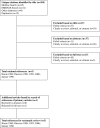Unexplained fractures: child abuse or bone disease? A systematic review
- PMID: 20878560
- PMCID: PMC3032841
- DOI: 10.1007/s11999-010-1578-z
Unexplained fractures: child abuse or bone disease? A systematic review
Abstract
Background: Child abuse and neglect (CAN) is a serious problem that has major implications for the welfare of the child involved. Unexplained fractures are of particular concern to the orthopaedic surgeon, who must often consider alternative diagnoses to CAN.
Questions/purposes: We therefore (1) determined which bone diseases most commonly mimic CAN; (2) what types of osteogenesis imperfecta (OI) are most commonly confused with CAN and why; and (3) what specific findings in OI and bone disease render a mistaken diagnosis of CAN more likely.
Methods: A systematic review of the literature was performed. We identified studies that compared cases of CAN with cases in which patients had bone disease that resulted in an unexplained fracture. We also included studies in which patients with fractures resulting from underlying bony pathology were misclassified as CAN and were subsequently reclassified as bone disease as a result of further investigation. Our search netted only five studies that directly compared and contrasted CAN with metabolic or genetic bone disease in the same study.
Results: The published literature suggests OI is most frequently confused with CAN, although metaphyseal dysplasia, disorders of phosphate metabolism, and temporary brittle bone disease are also documented in the literature identified by our search. Difficulty in differentiating these bony diseases from CAN stems from ambiguity in the history and physical examination at the time of presentation.
Conclusions: Bone disease is a diagnosis of exclusion in the differential diagnosis of CAN.
Figures
Comment in
-
Letter to the editor: Unexplained fractures: child abuse or bone disease: a systematic review.Clin Orthop Relat Res. 2011 Sep;469(9):2654-5;author reply 2656. doi: 10.1007/s11999-011-1954-3. Clin Orthop Relat Res. 2011. PMID: 21691905 Free PMC article. No abstract available.
-
Letter to the editor: Unexplained fractures: child abuse or bone disease: a systematic review.Clin Orthop Relat Res. 2011 Nov;469(11):3253-4; author reply 3255-6. doi: 10.1007/s11999-011-2021-9. Clin Orthop Relat Res. 2011. PMID: 21842296 Free PMC article. No abstract available.
References
-
- Fleiss J. Statistical Methods for Rates and Proportions (2nd Ed.). New York, NY: John Wiley & Sons; 1981.
Publication types
MeSH terms
LinkOut - more resources
Full Text Sources
Medical


